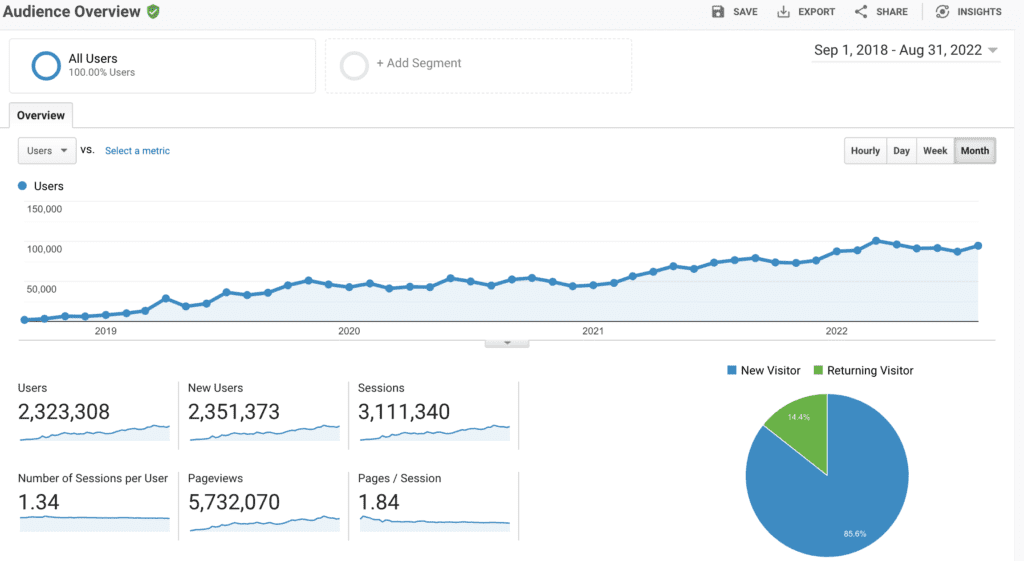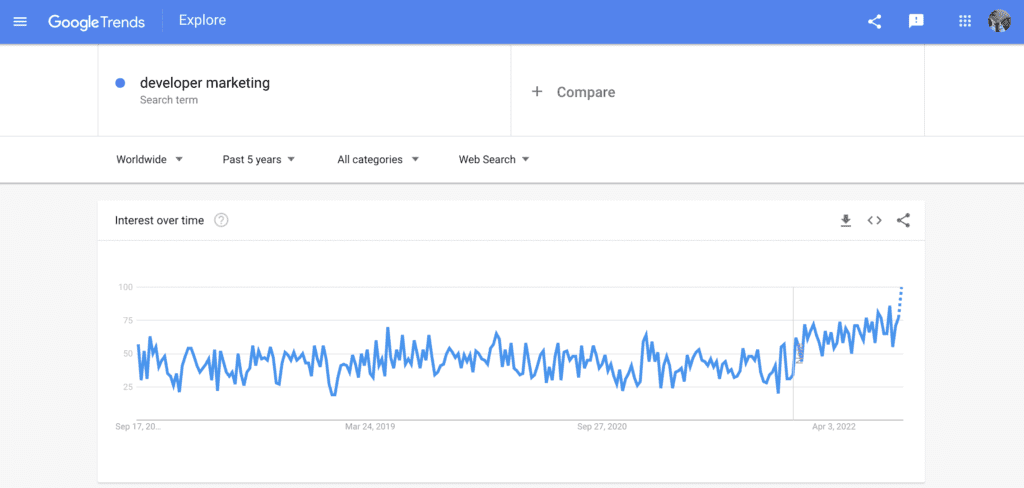TL;DR
- Developers decide adoption; market with clarity, honesty, and feature-focused content, not hype.
- Lead with product-led growth; provide docs, free trials, and learning resources.
- Use channels devs frequent: Reddit, LinkedIn, Dev.to, Discord, Product Hunt, Carbon Ads.
- Measure impact via traffic, signups, conversion rate, CAC, and engaged followers.
Fact Box
- Flatlogic site had 1M+ developer visits over 4 years.
- About 100k developers visit Flatlogic monthly.
- Flatlogic products have 1,000+ purchases/subscriptions.
- Flatlogic OSS projects have 2k+ stars and ~500 forks on GitHub. Source
- Used by developers at Google, Samsung, Walmart, Whirlpool.
Initial thoughts
This article was written by the marketing team of Flatlogic. Flatlogic full-stack AI web application generator is a tool for the fast creation of web applications from scratch. The tool provides the UI for creating the database schema from which you generate the application code base. All you have to do is to think about the database schema of your future application.
You can create almost any type of web application with the help of the tool:
- CRM;
- Headless CMS;
- E-commerce CMS;
- Admin Panel;
- Data management app;
- Inventory management application;
- UI for the database.
You may ask why this article might be useful to you and why you should trust the Flatlogic team:
- Our products are used by developers from companies such as Google, Samsung, Walmart, Whirpool, etc;
- For 4 years, our site has been visited by more than a million developers;
- Our products have been bought or subscribed more than 1000 times;
- About 100 thousand developers visit our site every month
- We have grown the audience of developers and sales almost from scratch.

Challenge
The main problem facing the tools that developers are users of is that marketers are trying to use approaches to popularize B2C products. Which at first glance is the right decision, since developers are individual consumers, not businesses. Understanding that founders possess unique behaviors and thought processes is crucial, especially when designing business software that meets their specific needs, a topic we’ll delve into further in this article to provide comprehensive insights.
What is developer marketing or marketing to developers?
Marketing to developers is a mix of tactics, strategies, and growth hacking tricks to acquire engineers in your tools, SAAS services, and other products. In other words, all actions to get your product adopted by software developers. 
Marketing to developers is a trend that has been actively developing lately (see a screenshot from Google Trends). This is because the number of developer tools is growing as well as the number of investments. And also the number of developers is growing.

Perhaps someone thinks that marketing for developers is no different from other groups, and can show that it is simple, but that is not true. Later in this article, we see how it is different from other marketing to other groups of customers.
Why you need to do marketing for developers
Products are becoming more complex and comprehensive, so if your audience is not developers initially, then later it is not always obvious who will use the product or integrate it. Thus, in the modern world, developers are increasingly influencing decisions about the use of a particular product.
For example, we all know advanced analytics systems such as Mixpanel or Amplitude, which are fundamentally the same. The implementation of these products requires the help of the developer, so the product that communicates clearly with the developer through clear documentation or tutorials can capture a large market share.
The second important point, and here we’ll be brief and agree with most of our industry peers, is that traditional marketing approaches often don’t work with developer audiences. To be successful, you often need to take counterintuitive actions. For example, tell developers, not about benefits, but the features of your product.
What you can market to software developer
You might promote open-source software, dev tools, APIs, SaaS platforms, SDKs, or everything in between. You can even market tools that were designed not for developers initially the implementation of those tools almost completely depends on developers, so they decide whether to use those tools or not. The best example is Stripe where the main users are businesses but to start using Stripe you should ask for help from developers.
Principles of marketing to developers
Honesty. Don’t trick them
Be honest about your product. If it has flaws, you can write about them and it will be appreciated. If you state that you are doing that 2 times faster – believe the developers will check it.
Usefulness
Make sure the marketing materials you distribute to the public are genuinely beneficial. Because they are inherently inquisitive, engineers are much more likely to be interested in information that teaches them something than in content that only tries to sell them something.
Clarity
Engineers love clean text. Even if you are writing an article for a blog, it can be similar to technical documentation without unnecessary epithets and with code examples.
Developers love to learn new stuff
Another important principle is that developers want to learn, develop, and compare several types of products, and decide for themselves what to buy. BUT developers don’t like it when they convince you to buy something, i.e. Sell.
Counterintuitive approach
Do the opposite with what you are told in classic marketing approaches – for example, sell value, not features. On the contrary, developers can sell dry text about features and not about value.
Free stuff
Engineers love to test things before they buy, so be sure to include free plans or demos with your product.
Which products should invest in marketing to developers?
If your product solves the problems of software engineers, then you will naturally have to invest in marketing for developers.
Also, if the implementation of your product requires the help of a developer, you should give a fair amount of marketing to the developer. Since it will influence the decision to use a particular product.
Also, marketing for developers will be useful for those organizations that profess an approach to sales from the bottom up. This is when a few people start using your tool and then they distribute your tool to the entire organization.
Why classical marketing tactics aren’t working for developers?
Disclaimer, this section will be full of cliches, so do not take what is written here as a guide to action, because any principle listed here can still work with the developer audience.
And so let’s go in order of why conventional marketing strategies and tactics may not work with developers:
- Developers, due to their professional characteristics, are quite skeptical customers and users. They prefer to try the product before they buy it, and you can often hear the phrase – “I’ll do it myself.”
- Compared to a wide audience of clients, developers have few or no sites where only they exist. Accordingly, there is no platform where you can catch all the developers, unlike, for example, if you are doing marketing for an online store with a wide range of products.
- Engineers often use ad blockers or anonymization tools (eg detect browsers such as gologin.com and VPN services). Accordingly, it can be quite difficult for you to understand the demographics of your users and, for example, set up ads correctly or even show them at all.
- Developers naturally hate marketing. Often they have some kind of natural flair for marketing techniques and content that is not honest with them. More precisely, they do not like it when they shove something and sell, or manipulate it. For most devs, however, “marketing” = “advertising”.
- Developers tend not to charge for services that are either free or easy to perform on your own. However, they may and will gladly accept payment when. There are no viable choices. Or they tried this little GitHub repo and couldn’t get it to work, or they got burnt to attempt to create it themselves, or they realize the actual cost of tools isn’t in the licensing but maintenance and support.
- Software developers are more interested in a product’s features than its advantages. As a result, you are not required to sell them anything in the traditional sense.
Questions to test whether you have marketing to developers
Let’s also determine if you already have any of the developer marketing elements. To do this, you can ask a few test questions to yourself and the product:
- Does your product solve any problems for developers?
- Is there an element in your product that requires the work of an engineer?
- Does your product have an API?
- Do you have separate written documentation for developers?
- Do you have or produce content specifically for developers?
- Do developers talk about your product or not?
- Is your product shared in the developer community or not?
- Do you communicate with developers in any community?
- Do developers give feedback on your product or not?
The answers to these questions will help you decide on a statistical point where to start your journey of marketing your product to engineers.
Strategy for marketing to developers
So now let’s move on to the most interesting and tasty part of this article. How to interact with developers so that they love your product, use it, and share it.

The most important thing you should decide on is to know your user very well. Ask questions such as:
- What technologies does he use?
- What resources does he read? For example blogs and newsletters.
- What do developers think?
From the answers to these questions, you will determine your positioning and the message of your product, as well as determine the channels through which to promote your product.
In the opinion of the Flatlogic team, the coolest strategy to attract engineers to your product is to make a useful product. Voila! He can solve a very small problem, but really solve it, and then just honestly share this solution with the community. After that, if you just communicate honestly and openly with users, the developers themselves will advise you. Now, this approach is formally called product-led growth. When you attract more and more new users with your product.
Example: We at Flatlogic help to get a web application up and running quickly compared to developers making their toolset to create an application’s boilerplate. This is confirmed by the fact that our products have already been downloaded tens of thousands of times and bought more than a thousand times.
Another important approach to attracting developers to your product is solving real-world developer problems. Providing products, resources, and solutions to help augment developer tech stacks to improve workflow and development efficiency. It can be useful blog posts, guides, free products, and open-source products.
Example: Flatlogic has open-source products that have collected more than 2 thousand stars and almost 500 forks on GitHub and solve urgent problems for developers – https://github.com/flatlogic/awesome-bootstrap-checkbox and other products of our public page on GitHub.
In general, these two broadcast and cost-to-develop tactics for marketing to developers.
Channels and tactics on how to attract developers to your tool
Let’s list the channels and tactics that you can use to attract developers to your product or service.
Channels
Social media
One of the most effective channels. It can work both as a communication channel with developers and as a channel for distributing your content. If we take specific platforms, then most often developers spend on LinkedIn and Reddit. The educational content on TikTok is also gaining popularity right now.
Developer communities
The developer community is quite fragmented and divided based on different technologies. As for platforms, you can find different communities on Reddit, Discord, and Slack chats.
Developer media platforms
In the past few years, such platforms have emerged to write content only for developers. You can write content both from yourself and from your company on sites such as Dev.to, Hashnode, Gitconnected.
Ads
To attract developers, you can use classic advertising networks such as Google Ads, Facebook Ads, Twitter Ads, and niche sites like Carbon Ads which are specifically built to promote developer tools. You can also use ads on Quora or Stackoverflow where the main audience is software engineers.
News/Content aggregators
And of course, one of the most effective ways to spread the word about your product is to post on sites like ProductHunt, Hackernews, and others. But do not abuse these tools, if you spam you will most likely get banned.
Listings/Review Platforms
You can also list your product on product review aggregators such as G2Crowd, Capterra, and Trustpilot. If you get enough good reviews there, then you will attract good traffic from those people who are already looking for a solution to their problem.
Tactics of marketing to developers
Now let’s move on to the actual execution part. What can you do to attract developers to your product? Let’s Go!

Writing valuable content
One of the most important components in marketing for a developer is the production of useful content. And here this work is broken down depending on the platform where you will produce content, what kind of content you will make and how you will find ideas for content.
Documentation and changelog
Yes, yes, one of the most effective ways to make your product attractive is to write good documentation with guides and examples, well readable and constantly updated. The changelog is also a thing that allows developers to see how the product has developed, and how often it can wait for releases with updates.
Company blog
In a blog, you can write both press releases about your product and comprehensive guides on how to solve the pressing problems of developers. You can also write about common topics in the software development world – this is called awareness-driven content and it helps to fill the top of the funnel and also increases your brand awareness.
Contribute to the blog of other companies
You can also write content for other companies’ blogs. If you write good content, then your partner will be happy to link to your product.
To generate this kind of content, it may be a good strategy to bring in engineers who work for your company, as the best content comes from when developers write for developers. You can also write with a request to contribute to your blog and other developers. For example, you can go to the Digital Ocean blog and see the authors who write content for them and contact them with a request to write an article for you.
Ideas for what content to write
- You can look at what questions engineers ask on StackOverflow and write more detailed answers to these questions;
- You can also write better articles than competitors;
- A useful tool would be to use tools like ahrefs, moz, se ranking to keep track of the number of requests for a particular issue;
- Guides on how to do something useful with your product would also be good content, for example.
Use quality ads
Advertising is also a good way to promote your product. In general, developers do not really like being advertised for something, but some tools allow you to make advertising very intuitive and not annoying. For example Carbon Ads – where your ads appear next to content that’s valuable to your audience and relevant to your brand in the form of a non-irritating banner.
In addition, you can order advertising in a large newsletter for developers. Probably the biggest resource is email newsletters from cooper press media.
Partnership with open source tools
Sponsorship of open-source tools is a good channel to attract traffic and brand awareness. You can sponsor open source products in your niche through open collective or directly through GitHub.
Community building
Utilize developer communities to establish, nurture, and strengthen connections with developers (developers). As previously indicated, a successful social media marketing approach for B2D enterprises incorporates Developer Relations and Developer Marketing efforts (DevRel).
Make your technology open source
One of the coolest tactics is when you decide right at the beginning of the product that your product will be open-source. Thus, if you can build a great community around your product, then you will get yourself the most devoted fans and proselytes of your product.
If you already have a product that is distributed under a commercial license, then you might consider making some of the modules or extensions for your open-source product.
Create free developer tools
And then one of the coolest channels can be the development of a free but very useful product for developers. A great example is Retool with their Developer Utility tools, where they have different tools like Convert CSV to JSON or Comma Separator. Moreover, their free products are made based on their tool.
Make video content
At present, this can be the main channel for promoting content and product. The younger generation of developers learns to program on YouTube a lot. Accordingly, to catch them there, you can release useful video content, and you can also organize live coding streams on Twitch. Well, of course, TikTok, more and more people are watching the content on this platform and getting some useful information from there.
Influencer marketing
You can also buy a review or integration of your product from famous software development bloggers. As a rule, if a blogger already has several tens of thousands of subscribers, he has already worked out a system for selling advertising and he knows approximately the number of leads that he will bring.
We at Flatlogic somehow partnered with bloggers on TikTok (here is a video) and the ROI was high. After that, several clients converted to our platform.
Attend or create events or meetups
You can either go to some existing conferences and collect real feedback from the developers, you can also sponsor such conferences, or you can organize conferences yourself. Either way, it’s a great way to get your product out there.
In conclusion, I would like to say that you just need to try and test each of the channels and tactics, and also not be limited to only one way. All you need to do is start!

Metrics
How to identify that you are doing the right things? Sales and revenue. All your efforts must end with these metrics.
But before that, you can also determine by other metrics whether a particular channel or tactic is working well. So let’s look at core metrics.
Traffic
One of the main metrics by which you can determine whether you are doing your actions well. The more quality traffic comes through each channel, the more likely your product will be noticed and used.
Number of registrations
If your product requires registration to use it, then this is also one of the metrics that help you understand how high-quality traffic you attract and how well the positioning and message, the content of your product, works.
Conversion rate
This indicator shows how well your product solves the tasks of developers in general, as well as how well your marketing works, i.e. Were you able to make it clear to the developer that your tool is useful?
Cost of acquisition
This indicator reflects how much you spent on the acquisition of one user. Depending on the product paid or free. Actually, according to this indicator, the ROI of each marketing channel is considered. Accordingly, the less CAC, the better for your business and the more you need to scale the marketing channel.
Social media followers
This indicator is important if you are developing an SMM channel. In this case, the most important thing will probably not even be the number of subscribers, but their quality and engagement.
TL:DR What you need to do to successfully market your product to software developers
- Developer marketing is a collection of techniques intended to recruit, engage, and encourage developers to use your product.
- Not only do you need to promote developer tools, but also the products whose implementation requires developer effort.
- Six guiding principles apply to marketing to developers: Sincerity, utility, and clarity Devs love to learn new things, use counterintuitive strategies, and provide free items
- There are relatively few venues where you would discover developers to promote them because the developer community is diverse and dispersed.
- Software developers are more interested in a product’s features than its advantages.
- There are six primary ways to get in touch with developers: Advertisements, news/content aggregators, developer communities, and platforms for developer media.
- Your developer marketing campaign’s performance may be evaluated using the following five KPIs: Traffic, registrations, conversion rate, acquisition costs, and social media following are all important metrics.
- There are nine typical developer marketing strategies: Writing informative articles, using effective advertisements, collaborating with open source software, fostering a sense of community, making your technology open source, producing videos, creating free developer tools, and influencer marketing are all ways to improve your online presence.
That’s it!
If you have any questions or want to add something feels free to contact us or leave comments under this article. Hope you have enjoyed reading it.
Comments